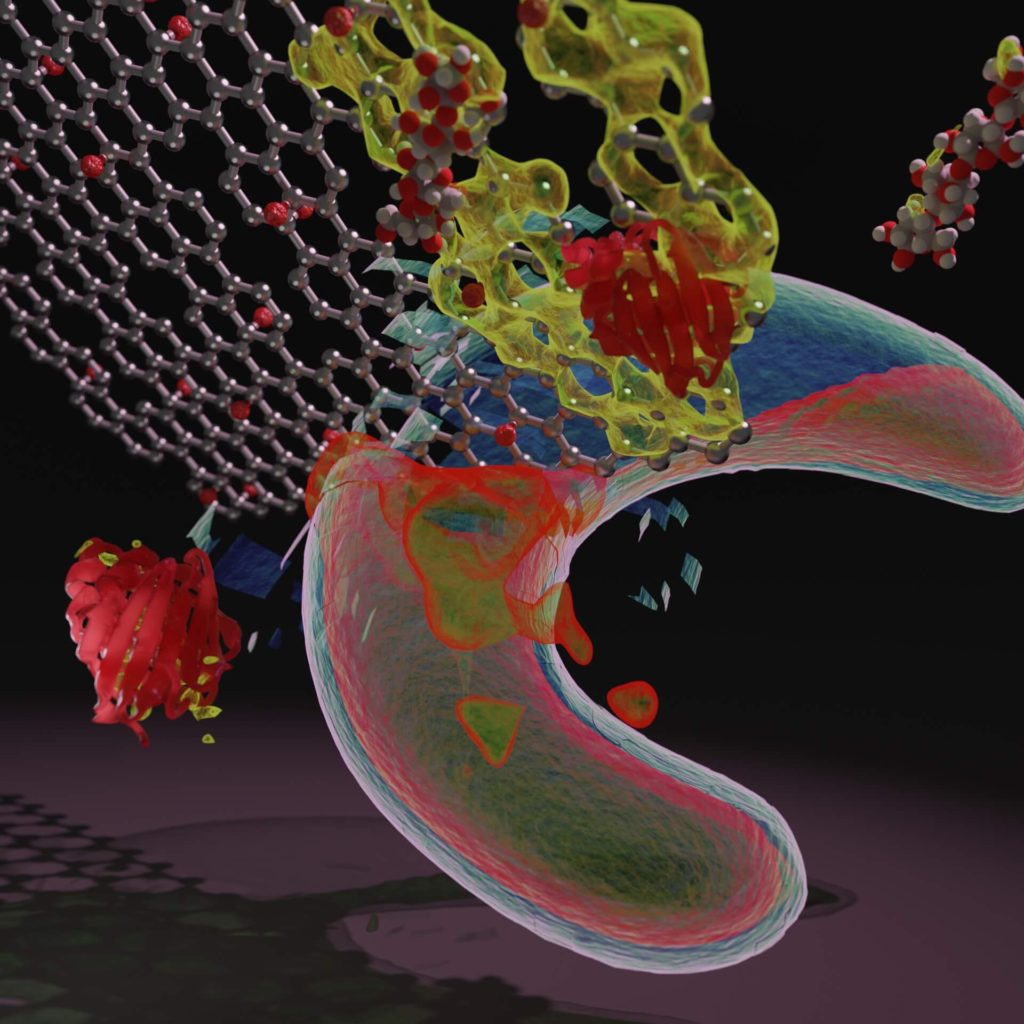Chemically modified 2D materials can act as toxic blades for water organisms
Researchers from the Regional Centre of Advanced Technologies and Materials (RCPTM), Palacký University Olomouc, in collaboration with colleagues from the Institute of Botany of the Czech Academy of Sciences shed light on the potential negative impact of carbon nanomaterials on the microorganisms present in aqueous environments. They confirmed that on certain conditions chemically modified graphene can change into “nano-blades” that damage algae in water. However, it was found that these unicellular organisms can build, over the time, an effective defence against such mechanical attacks, making them capable of dealing with them. The results of the study were published in the journal Carbon1.
Chemically oxidized graphene (single atomic layer of graphite whose rediscovery was awarded a Nobel Prize in Chemistry in 2010) is one the most widely studied two-dimensional materials up to date. “Unlike graphene, oxidized graphene (graphene oxide) disperses well in water, thus offering broad application potential, e.g. in biomedicine in targeted drug transport, in new technologies for energy storage and in a number of environmental technologies. Graphene oxide has been proven working for desalination or in the removal of radionuclides and other pollutants from water. In this regard, the scientific community has been investigating whether oxidized graphene can negatively impact microorganisms living in surface waters. The aim of our research was to identify the mechanism of interaction between these carbon 2D materials and algae and cyanobacteria, which form a fundamental part of the food chain in water ecosystems”, said the main author of the study, Tomáš Malina, RCPTM.

The researchers prepared three chemical forms of nanomaterials having different levels of oxidation. This proved to be essential. “The graphene that had the lowest number of functional groups on its surface was able to physically damage microorganisms. It acted like a fairly large but very thin blade of a knife or razor, which disrupted cell membranes. By contrast, graphene materials with a higher number of bounded functional groups did not possess this ability. These findings are novel. Complex mechanism of the behaviour of oxidized graphene in contact with these simple organisms and mainly the impact of its surface chemistry on the overall ecotoxicity of these materials was not described previously”, added Malina, who conducted the research as part of his PhD studies.
An important finding is that micro-organisms can develop defensive mechanisms against such 2D nano-blades. “With the example of algae, we demonstrated that the most devastating impact of these microorganisms occurred only in the first hours of the interaction, but then the algae were able to effectively face the danger. They began to produce proteins and hydrocarbons so that they managed to coat graphene oxide with these molecules, thus averting the danger. Therefore, the environmental risk of graphene materials has been proved significantly lower than was suggested. In the long term, even very simple organisms are able to defend themselves. Nature can handle nanomaterials,” said Blahoslav Maršálek from RCPTM and the Institute of Botany of the CAS, where the experiments with algae and cyanobacteria were performed.
The work follows long-term research done by RCPTM regarding the interactions of nanomaterials with biosystems and microorganisms. “Previously, we found a method for, e.g. overcoming bacterial resistance against nanosilver2, measuring temperature in living cells using carbon nanoparticles3 or diagnosing significant biomolecules using magnetic nanomaterials4,” concluded the corresponding author of the work, Radek Zbořil.
- T. Malina, E. Maršálková, K. Holá, J. Tuček, M. Scheibe, R. Zbořil, B. Maršálek, Toxicity of graphene oxide against algae and cyanobacteria: Nanoblade-morphology-induced mechanical injury and self-protection mechanism, Carbon 155 (2019), 386-396
- A. Panáček, L. Kvítek, M. Smékalová, R. Večeřová, M. Kolář, M. Röderová, F. Dyčka, M. Šebela, R. Prucek, O. Tomanec, Bacterial resistence to silver nanoparticles and how to overcome it, Nat. Nanotechnol. 13 (2018), 65-71
- S. Kalytchuk, K. Poláková, Y. Wang, J. P. Froning, K. Čepe, A. L. Rogach, R. Zbořil, Carbon Dot Nanothermometry: Intracellular Photoluminescence Lifetime Thermal Sensing, ACS Nano 11(2) (2017), 1432-1442
- V. Ranc, Z. Markova, M. Hajduch, R. Prucek, L. Kvítek, J. Kašlík, K. Šafářová, R. Zbořil, Magnetically Assisted Surface-Enhanced Raman Scattering Selective Determination of Dopamine in an Artificial Cerebrospinal Fluid and a Mouse Striatum Using Fe3O4/Ag Nanocomposite, Anal. Chem. 86(6) (2014), 2939-2946


